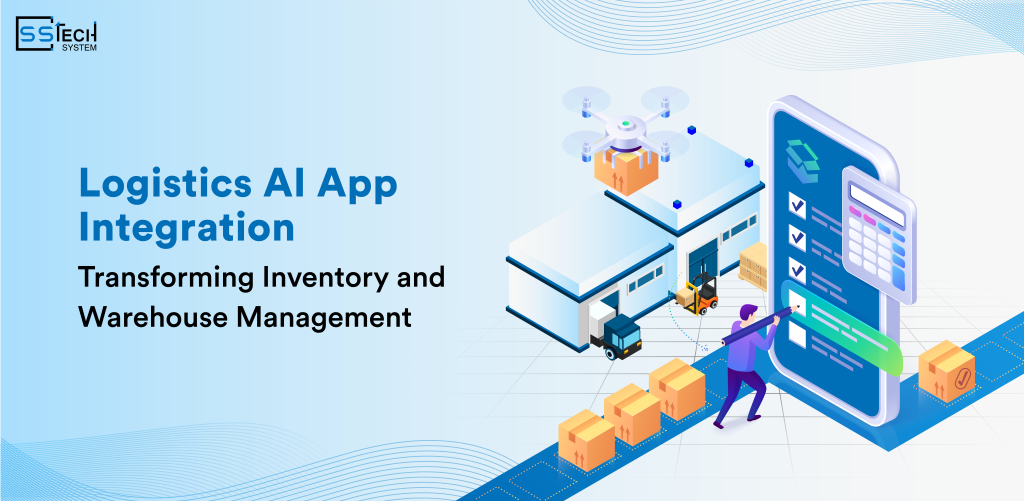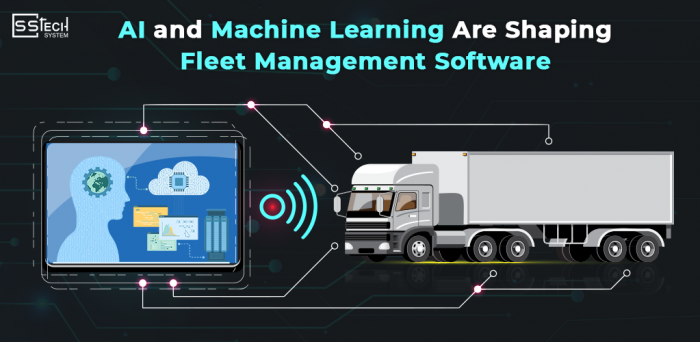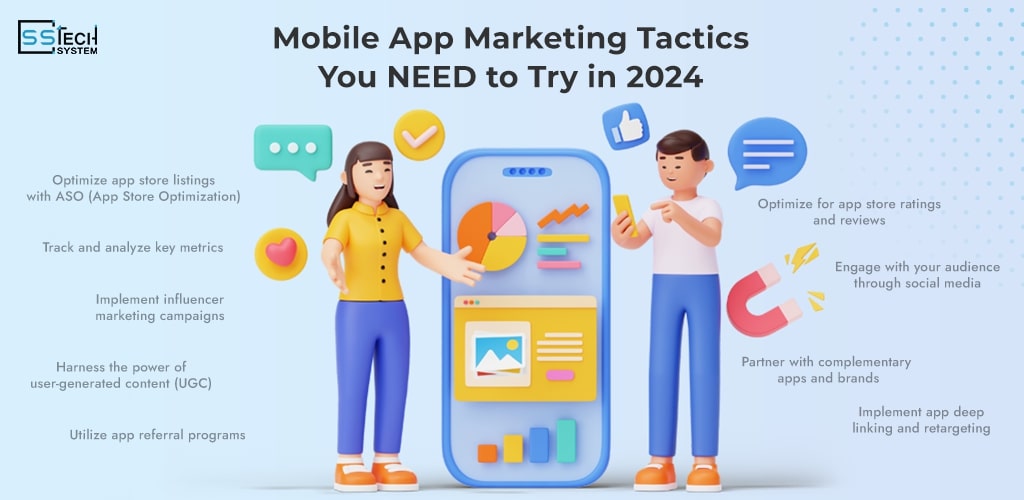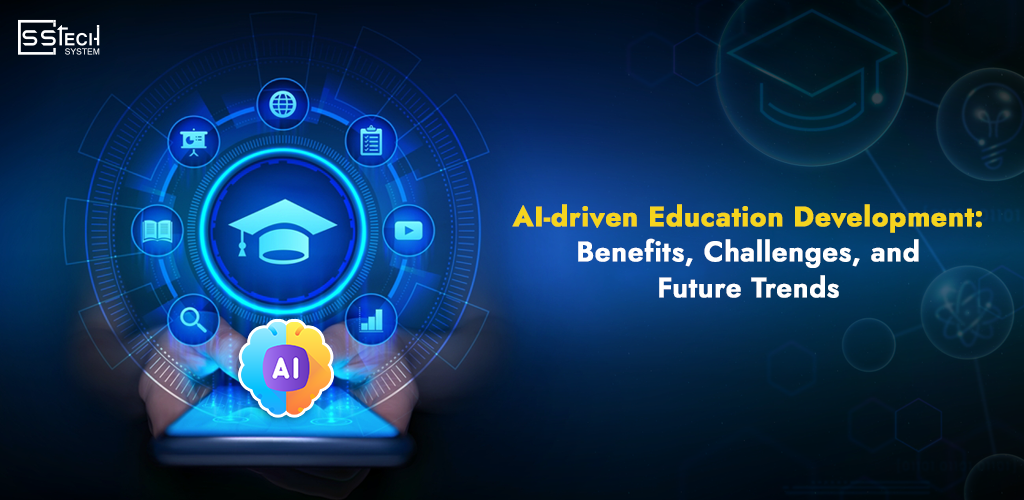
AI-driven education development has changed the way educational technologies are developed and used, therefore providing improved efficiency and personalizing in learning. This revolutionary approach—adding artificial intelligence (AI)—has brought about a sea of change in learning environments all around, including Australia, by including it into educational app development.
According to stats, AI in education is forecast to grow at a CAGR of 43.3%, reaching $88.2 billion by 2032. Platforms like AI education technology and School Management Software are becoming essential in modern education.
Companies like SSTech AI Development have great potential for AI-driven education, which offers chances to improve engagement for teachers and students both by means of refined learning strategies. This article explores the benefits, challenges, and future trends of AI in education, particularly focusing on AI-driven education Australia.
What is AI-driven Education Development?
AI-driven education development is the application of artificial intelligence to produce, adapt, and improve tools and platforms for learning. From AI development services in Australia to specific educational software, AI-driven approaches let teachers and developers employ data, machine learning, and automation to produce tailored, interactive, and interesting learning opportunities.
These innovations include sophisticated data analytics in education, thereby helping teachers to track performance, better grasp student needs, and customize learning paths. Learning is dynamic and adaptive since educational apps and software including machine learning in education can find trends and forecast results, therefore guiding the process.
Underlining AI Educational Platforms Australia, this technology lets students access materials catered to their strengths and shortcomings. It also drives elements in AI for Student Engagement and AI and Student Engagement Australia, therefore promoting engaging and inspiring learning environments.
Benefits of AI-driven Education:
1. Personalized learning paths
Since all students have a specific learning style and pace as well as performance, AI-based programs may develop content and lesson plans that match the learners.
AI education technology empowers instructors to develop learning plans that may be specific to the learners’ needs. For example, adaptive learning allows students to move through the content at a pace that is comfortable to them while ensuring mastery of concepts before proceeding.
2. Data-driven insights for teachers and administrators
Education system can make use of several data analytics that provide the use AI in the sense that it can identify the student’s performance, behavior and potential development.
This is useful in monitoring results and making good decisions with regards to enhancing the quality of teaching. It can also enable the teacher to focus more on teaching and less on paperwork, through the efficient use of school management software fitted with artificial intelligence.
3. Enhanced student engagement
One of the major advantages of AI for Student Engagement is the ability to provide interactive and immersive learning experiences. Examples include; AI based chatbots that can assist students in answering their questions immediately thus creating a conducive learning environment. In addition, especially for children, elements of games in artificial intelligence reinforced learning application ensure enhanced engagement and interest.
4. Cost-effective learning solutions
AI development services in Australia and globally are creating cost-effective solutions for schools, making high-quality education accessible to more students. By giving access to digital libraries and online learning resources, AI-driven systems can help to lower the demand for physical resources including textbooks. This accessibility supports an economically feasible and environmentally friendly educational paradigm.
5. Improved accessibility and inclusion
AI-powered educational software development solutions can be designed to cater to students with disabilities. By means of adaptive text characteristics, image identification, and speech recognition, artificial intelligence can offer students who would find conventional learning resources instructional materials, therefore promoting a more inclusive learning environment.
6. Efficient administration and operations
Using artificial intelligence-driven school management software helps educational institutions simplify tasks including grading, scheduling, and attendance tracking. AI frees staff time for value-driven activities by automating repetitive chores.
For instance, SSTech System Education Development offers customized AI solutions for school management, optimizing administrative functions with automation and advanced reporting.
7. 24/7 access to learning resources
Learning resources available to students via AI-powered educational systems are always available wherever. This adaptability lets students go over material, finish projects, and participate in conversations outside of regular classroom times. By means of AI-driven solutions such as AI-driven education apps, students may study at their own convenience, therefore facilitating more flexible learning environment.
Challenges of AI-driven Education
1. Privacy and data security
Because AI-driven education mostly depends on student data to customize learning experiences, privacy issues are greatly raised. Maintaining data privacy rules and fostering confidence among parents, teachers, and students depends on sensitive data being safeguarded.
Particularly when using AI for Australian Educators and other platforms in Australia, where data protection standards are high, schools and developers must put strict cybersecurity policies into place to protect this data.
2. High development and maintenance costs
Although AI-driven education can save long-term, the early development and implementation expenses can be significant. To stay effective, artificial intelligence systems call for experienced developers, large resources, and frequent updates. AI-powered educational software development solutions must be consistently maintained since the algorithms must change to fit changing educational needs and fresh data.
3. Lack of digital literacy among educators
The powerful technologies underlying AI education technology might not be known to many teachers. Schools have to make training investments to guarantee that teachers may properly apply AI-driven tools to help their students. The advantages of AI for student engagement and AI education technology could be less appreciated without appropriate digital literacy.
4. Risk of over-reliance on AI
Sometimes over-reliance on artificial intelligence tools reduces human interaction—a necessary component of a well-rounded education. Although artificial intelligence can simplify tasks and provide access to knowledge, the human component of education—that which includes empathy, creativity, and social skills—that cannot be substituted here. Providing complete education depends on juggling artificial intelligence tools with conventional teaching strategies.
5. Bias and fairness in AI algorithms
Only as objective as the data they are trained on are machine learning models. Particularly in diverse educational settings, bias in educational data might cause artificial intelligence systems to produce erroneous or unjust assessments. To guarantee AI-driven educational technologies are fair and equal, developers and institutions must carefully choose and track data inputs.
6. Technical infrastructure and compatibility issues
Many schools, especially in underfunded or rural locations, might lack the technical capability to implement advanced artificial intelligence technologies, therefore restricting the scope of AI-driven education. Furthermore impeding the deployment of new AI-based learning tools are compatibility problems with legacy systems. Significant infrastructural and hardware upgrades are required to enable AI-driven education to be generally available.
Future Trends in AI-driven Education
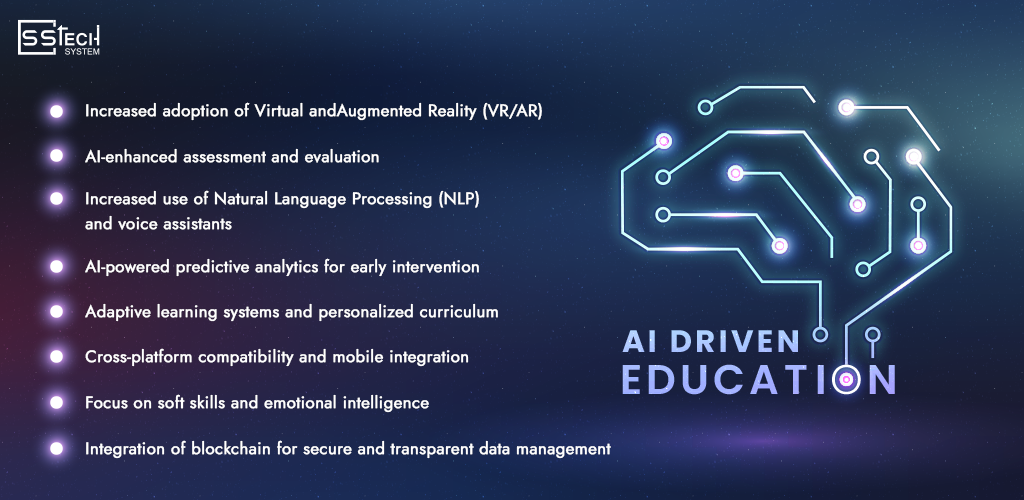
1. Increased adoption of Virtual and Augmented Reality (VR/AR)
The AR & VR market is set to nearly double between 2024 and 2028. VR and AR increasingly enhance AI-driven education by creating immersive learning experiences.
Thanks to these tools, students may interact with materials in novel, fascinating ways including virtual labs or historical simulations. Students will be able to investigate difficult topics as biology, chemistry, or history in an interactive 3D environment as AI Educational Platforms Australia follows similar trends.
2. AI-enhanced assessment and evaluation
Conventional approaches of evaluation might be time-consuming and arbitrary. By means of real-time feedback and evaluation grounded on data, artificial intelligence in education is altering the methodology of evaluations. AI-driven assessments make evaluations more thorough and perceptive since they may examine not just correct responses but also a student’s approach to solving problems.
3. Increased use of Natural Language Processing (NLP) and voice assistants
AI education technology is including voice-recognition technologies and natural language processing tools to help students with learning challenges improve language competency. Powered by AI, voice assistants can also help students with chores such homework reminders, class summaries, and vocabulary building, therefore fostering a more dynamic and encouraging learning environment.
4. AI-powered predictive analytics for early intervention
By means of data analytics in education, artificial intelligence may spot kids who run the danger of lagging behind and offer focused assistance before problems become major.
Predictive analytics can assist educators in knowing every student’s development and suggesting actions including further tutoring or curriculum changes. Using predictive analytics can help SSTech System Education Development and other providers improve student results.
5. Adaptive learning systems and personalized curriculum
AI for Student Engagement is moving toward adaptive learning systems that dynamically adjust instruction based on real-time student performance and engagement levels.
Adaptive learning driven by artificial intelligence gives pupils a curriculum catered to their aptitude and speed, therefore improving the learning results. Best AI education platforms are already using these methods to make education more responsive and personalized.
6. Cross-platform compatibility and mobile integration
The need for flexible learning solutions means that mobile app development is becoming crucial in AI education technology. We design educational platforms that function seamlessly across devices, from iOS development services to Android app development, enabling students to access their learning materials anytime, anywhere.
7. Focus on soft skills and emotional intelligence
Along with regular academic courses, future AI-driven education tools are probably going to stress emotional intelligence, creativity, and critical thinking.
By including sentiment analysis and emotional tracking, artificial intelligence is developing to let teachers know how their pupils feel and provide suitable help. Through the development of these solutions, SSTech System Australia and like businesses hope to offer complete educational experiences transcending mere academic learning.
8. Integration of blockchain for secure and transparent data management
Blockchain technology is projected to reach nearly 1,000 trillion U.S. dollars by 2032. It ensures that student data remains transparent, immutable, and secure, enhancing AI-driven education technologies.
With blockchain, educational institutions can maintain reliable records of academic achievements, making it easier for students to share credentials with prospective employers or universities. The integration of blockchain and artificial intelligence will provide a secure framework for the responsible management of educational data.
Conclusion
AI-driven education development presents unmatched advantages but also presents special difficulties that are reshining the nature of learning. Personalizing learning experiences, improving student involvement, and allowing data-driven insights help artificial intelligence to make education more efficient and accessible.
For responsible AI use, we must address privacy, cost, and dependency issues. As AI-driven education advances, tools like predictive analytics and adaptive learning will reshape learning, with SSTech System Australia leading the way.






